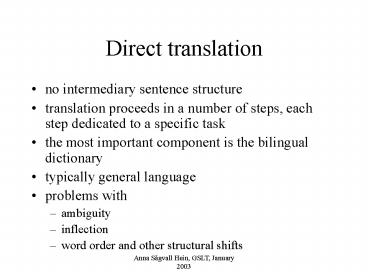Direct translation - PowerPoint PPT Presentation
1 / 13
Title:
Direct translation
Description:
translation proceeds in a number of steps, each step dedicated to a ... http://babelfish.altavista.com/) Anna S gvall Hein, GSLT, January 2003. Systran, cont. ... – PowerPoint PPT presentation
Number of Views:38
Avg rating:3.0/5.0
Title: Direct translation
1
Direct translation
- no intermediary sentence structure
- translation proceeds in a number of steps, each
step dedicated to a specific task - the most important component is the bilingual
dictionary - typically general language
- problems with
- ambiguity
- inflection
- word order and other structural shifts
2
Simplistic approach
- sentence splitting
- tokenisation
- handling capital letters
- dictionary look-up and lexical substitution
- copying unknown words, digits, signs of
punctuation etc. - formal editing
3
Advanced classical approach (Tucker 1987)
- Source text dictionary lookups and morphological
analysis - Identification of homographs
- Identification of compound nouns
- Identification of nouns and verb phrases
- Processing of idioms
4
Advanced approach, cont.
- processing of prepositions
- subject-predicate identification
- syntactic ambiguity identification
- synthesis and morphological processing of target
text - rearrangement of words and phrases in target text
5
Feasibility of the direct translation strategy
- Is it possible to carry out the direct
translation steps as suggested by Tucker with
sufficient precision without relying on a
sentence grammar and an intermediary structure?
6
Example, 1
- Sv. Ytterst handlar kampen för sysselsättning om
att hålla samman Sverige. - En. Ultimately, the fight for full employment
concerns the cohesion of Swedish society. - (from Statement of Government Policy 1996)
7
Assignment 1 Hable Con Ella (en-sv)
- Make a general quality assessment of the
translation. - Suggest a possible use of a translation of this
kind. - Identify the steps that were taken in the
translation. - Specify the translation errors that were made and
discuss them. - Suggest improvements in the framework of the
direct translation strategy. - Motivate them.
- Formalise them in a framework of your own choice.
- Discuss their general adequacy in the translation
of Swedish to English.
8
Current trends in direct translation
- re-use of translations
- translation memories of sentences and
sub-sentence units such as words, phrases and
larger units - example-based translation
- statistical translation
- Will re-use of translations overcome the problems
with the direct translation approach that were
discussed above? - If so, how can they be handled?
9
Systran
- System Translation
- developped in the US by Peter Toma
- first version 1969 (Ru-En)
- EC bought the rights of Systran in 1976
- currently 18 language pairs
- no Swedish
- http//babelfish.altavista.com/)
10
Systran, cont.
- more than 1,600,000 dictionary units
- 20 domain dictionaries
- daily use by EC translators, administrators of
the European institutions - originally a direct translation strategy
- see HS
- to-day more of a transfer-based strategy
11
Motivations for transfer-based translation
- lexical ambiguity
- structural differences
- See further Ingo 91 (6), Wikholm (89)
12
Example, 2
- Sv. Fyll på olja i växellådan. ?
- En. Fill gearbox with oil.
- (from the Scania corpus)
- fyll på ? fill
- obj ? adv
- adv ? obj
13
Example, 3
- Sv. I oljefilterhållaren sitter en
överströmningsventil. ? - En. The oil filter retainer has an overflow
valve. - (from the Scania corpus)
- sitter ? has
- adv ? subj
- subj ? obj































